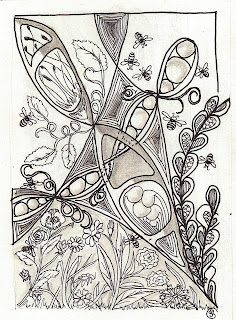Another new group: Ornate Animal Illustrations was started by Ben Kwok. We have all admired his animal artwork. It is different and beautiful. In this new group, Ben will post some of his animals in template form. These are to be downloaded by members, tangled, then uploaded to the site again, to share with other members. His group has had phenomenal growth, reaching the first 100 members in less than 48 hours! The first two templates were a flycatcher (bird) and a Dragonfly. They were lots of fun to tangle. (Yes, I tangled one of each and uploaded them. :)
With all of this going on, I have not had much time to experiment with the Mooka. However, there have been two new developments.The first is one I developed with flower blooms developing from the fronds and the second is a modification I came across while surfing the internet. To take the second variation first, the mooka fronds are drawn out with thread-thin stalks and elongated teardrop shaped fronds. This gives a larger area inside the fronds for coloring, or blending colors, or for including tangles, or even faces. It also makes it much easier to draw the fronds interweaving or braiding.
This shows the interweaving or braiding of the fronds.
The second variation was developed after seeing a tangle pattern for quilting a quilt. First, you draw the mooka in whatever form you wish. Next, you extend the frond stalk into the end of the frond to form something like a spiral:
Then, starting at the inside of the spiral, draw a small single leaf, Move outward a little and draw another leaf, a little larger. continue in this manner, working you way around the spiral.'
Finally, continue working you way down the stalk. Go back, then, and fill in the blank spaces between the petals:
You can then embellish the mooka however you want. I have shown cirliques above. Below, a mooka is partially hidden behind a netting.
Well, I hope you have found something interesting here this week. I hope to see you in about another week. :)


















































